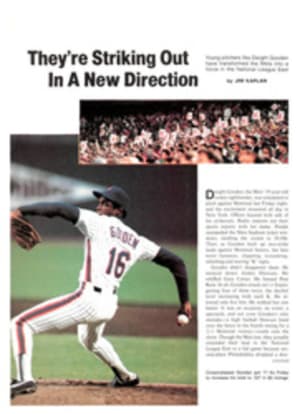
THE BEST OF FLIES ARE THOSE THAT CAN CATCH FISH AND THE IMAGINATION
You might guess that the names Hairy Mary, Alaska Mary Ann and Big Bertha belong to roller derby stars. They don't. They're fly patterns, marvelous blends of fur, feathers and tinsel designed to catch the attention of Atlantic salmon, steel-head and trout.
These three flies and myriad others make up the longest and most colorful roster in sport. There are at least 10,000 published fly patterns, and an amazing number have names as vivid as the flies themselves. What other sport offers its enthusiasts a chance to hook up with a Rich Widow or cast a '52 Buick? Where else but among fly-fishers could you walk around with a bunch of Dead Chickens stuck in your hat and not cause a stir?
Most good fly tiers consider themselves artists, and their artistic creations worthy of ingenious names. Moreover, when flies are made to be sold, those that have colorful names have a much better chance of commercial success than those that haven't. Which would you select: a Brown Grub or a Pink Lady?
Nomenclature has come a long way since the first definitive mention of a specific artificial fly appeared in Aelian's Natural History. "I have heard of a Macedonian way of catching fish," Aelian wrote in the 3rd century A.D. and went on to describe how the Macedonians fastened red wool around a hook and attached "two feathers which grow under a cock's wattles, and which in color are like wax" to imitate a fly they called the Hippouros. It wasn't much of a fly—or a name—but it was a beginning.
After Aelian there was a gap in the literature until the appearance in 1496 of The Treatyse of Fysshynge wyth an Angle, usually attributed to a shadowy figure known as Dame Juliana Berners. The Treatyse listed a dozen fly patterns and recommended the best time for their use in English trout streams. It was obvious that it had taken awhile to gather this information, indicating that fly-fishing and fly tying had been evolving in England for some time. Even so, the names of the flies lacked imagination by today's standards. They included a couple of Dun Ryes, a Stone Flye, a Yellow Flye and a Tandy Flye. Only one of the 12 patterns had a name that might have earned it a second glance on a modern tackle-shop counter—the Blacke Louper (leaper).
But these 12 flies were the foundation for a rich tradition of English fly dressing that produced many beautiful patterns with equally alluring names such as: the Iron Blue Dun, Greenwell's Glory, the Pale Evening Dun, Tup's Indispensable and the Welshman's Button.
As fly-fishing spread to the New World, North Americans contributed original names. Among the best: the Parmachene Belle, Skykomish Sunrise, Sofa Pillow, Norwegian Moustache, Rusty Rat and Warden's Worry.
Although fly-fishing has always been something of a rulebound sport, there are no rules for naming a new fly pattern. Some reflect impulse or whimsy, some are named after long, careful thought. Some bear the names of their originators, or of the rivers where they were first tried. Some have mysterious names—Black Dose, Gray Ghost, Coffin Fly—and some have names that are revolting, such as the Maggot, Cowdung, Bloody Butcher and Rat-Faced McDougal.
Royal and professional titles account for a disproportionately large share of fly pattern names. Patterns named after kings, queens, princes and lords are a dime a dozen, and there's a good deal of representation on the part of the military. At least half a dozen well-known patterns are styled after colonels, at least three after generals. There're also the English Admiral, the Major, the Patton and the all-encompassing Brass Hat. Lower ranks don't seem to merit consideration among fly tiers; there appear to be few published patterns named after lieutenants, NCOs or privates.
After golf, fly-fishing must be the favorite diversion of the medical profession, judging by the number of flies named after doctors. Patterns include the Silver Doctor, Golden Doctor, Lady Doctor and Quack Doctor; the Dr. Burke, and Dr. Spratley; the General Practitioner and the Surgeon General.
Lawyers, on the other hand, lag far behind. There are the Old Judge and the Bronson's Barrister, but that's just about it. Fly patterns reflecting religious influences include the Deacon, Quaker, Parson's Glory, Priest, Bishop's Blessing and Redeemer. Ominously, there's also a fly called the Presbyterian Killer.
There's even one named Lady Godiva. One might surmise that it's a bare hook, but actually it's a handsome steelhead fly.
Despite the long tradition of giving fly patterns colorful names, lately there has been an alarming increase in dull names, such as Dave's Green Bug or Joe's Special. Worse yet, some tiers have abandoned names altogether and are simply labeling flies with numbers or initials.
One hopes this trend will be short-lived. But even if it isn't, the old names will live on, as will our curiosity as to their origins. What delicious tale could have prompted one tier to style his fly the Family Secret?
And for that matter, where did the names Hairy Mary, Alaska Mary Ann and Big Bertha come from? What did their namesakes do to merit immortality, alongside all those kings and queens?
ILLUSTRATION
ARNOLD ROTH

